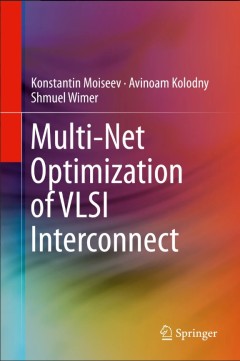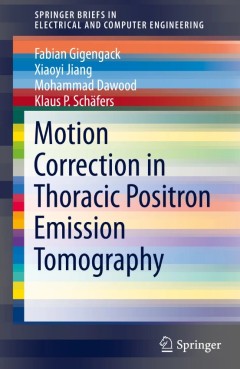Filter by

Molecular and Cellular Mechanobiology
This book will cover the cutting-edge developments in molecular and cellular mechanobiology to date. Readers will have a clear understanding of mechanobiology at the molecular and cellular levels, encompassing the mechanosensors, transducers, and transcription. An integrative approach across different scales from molecular sensing to mechanotransduction and gene modulation for physiological reg…
- Edition
- 1
- ISBN/ISSN
- 978-1-4939-5615-9
- Collation
- XIII, 302
- Series Title
- Physiology in Health and Disease
- Call Number
- -

Multi-Net Optimization of VLSI Interconnect
This book covers layout design and layout migration methodologies for optimizing multi-net wire structures in advanced VLSI interconnects. Scaling-dependent models for interconnect power, interconnect delay and crosstalk noise are covered in depth, and several design optimization problems are addressed, such as minimization of interconnect power under delay constraints, or design for minimal de…
- Edition
- 1
- ISBN/ISSN
- 978-1-4614-0820-8
- Collation
- XVI, 233
- Series Title
- -
- Call Number
- -

Motion Correction in Thoracic Positron Emission Tomography
Respiratory and cardiac motion leads to image degradation in Positron Emission Tomography (PET), which impairs quantification. In this book, the authors present approaches to motion estimation and motion correction in thoracic PET. The approaches for motion estimation are based on dual gating and mass-preserving image registration (VAMPIRE) and mass-preserving optical flow (MPOF). With mass-pre…
- Edition
- 1
- ISBN/ISSN
- 978-3-319-08391-9
- Collation
- XI, 88
- Series Title
- SpringerBriefs in Electrical and Computer Engineering
- Call Number
- -

Molecular Structures and Structural Dynamics of Prion Proteins and Prions
This monograph is the first easy-to-read-and-understand book on prion proteins' molecular dynamics (MD) simulations and on prions' molecular modelling (MM) constructions. It enables researchers to see what is crucial to the conformational change from normal cellular prion protein (PrPC) to diseased infectious prions (PrPSc), using MD and MM techniques. As we all know, prion diseases, caused by…
- Edition
- 1
- ISBN/ISSN
- 978-94-017-7317-1
- Collation
- XIX, 355
- Series Title
- Focus on Structural Biology
- Call Number
- -

More than Moore Technologies for Next Generation Computer Design
This book provides a comprehensive overview of key technologies being used to address challenges raised by continued device scaling and the extending gap between memory and central processing unit performance. Authors discuss in detail what are known commonly as “More than Moore” (MtM), technologies, which add value to devices by incorporating functionalities that do not necessarily scale a…
- Edition
- 1
- ISBN/ISSN
- 978-1-4939-4710-2
- Collation
- -
- Series Title
- -
- Call Number
- -

The Teaching Profession Present and Future
This volume contributes to debates about the teaching profession by reviewing international and national reports on its status, as well as on reforms of various education systems. It proposes a global approach to the quality of the teaching profession as a decisive ingredient of education quality, including a conception of its identity and a vision of its future. Moreover, it is suggested that …
- Edition
- -
- ISBN/ISSN
- 978-3-319-12130-7
- Collation
- -
- Series Title
- -
- Call Number
- -

Monitoring and Evaluation of Production Processes:An Analysis of the Automoti…
This book presents topics on monitoring and evaluation of production processes in the automotive industry. Regulation of production processes is also described in details. The text deals with the implementation and evaluation of these processes during the mass production of components useful in the automotive industry. It evaluates the effects and results achieved after implementation in practi…
- Edition
- 1
- ISBN/ISSN
- 978-3-319-29441-4
- Collation
- XX, 117
- Series Title
- -
- Call Number
- -

Molecular Pathology in Cancer Research
Cancer Biology, Medical Genetics, Cell Biology, Protein Biochemistry, Molecular Genetics
- Edition
- 1
- ISBN/ISSN
- 978-1-4939-6641-7
- Collation
- VIII, 369
- Series Title
- -
- Call Number
- -

Molecular Mechanisms of Cell Differentiation in Gonad Development
This book presents the current state of knowledge on the origin and differentiation of cell lines involved in the development of the vertebrate male and female gonads with particular emphasis on the mouse. It also discusses the processes leading to the testis- and ovary-specific structures and functions. The individual chapters review the origin and differentiation of the somatic cells of th…
- Edition
- 1
- ISBN/ISSN
- 978-3-319-31971-1
- Collation
- XII, 434
- Series Title
- Results and Problems in Cell Differentiation
- Call Number
- -

Modern Cold Spray:Materials, Process, and Applications
This book focuses on the current state of the art of the novel cold spray process. Cold spray is a solid state metal consolidation process, which allows engineers to tailor surface and shape properties by optimizing process parameters, powder characteristics and substrate conditions for a wide variety of applications that are difficult or impossible by other techniques. Readers will benefit fro…
- Edition
- 1
- ISBN/ISSN
- 978-3-319-16771-8
- Collation
- X, 429
- Series Title
- -
- Call Number
- -
 Computer Science, Information & General Works
Computer Science, Information & General Works  Philosophy & Psychology
Philosophy & Psychology  Religion
Religion  Social Sciences
Social Sciences  Language
Language  Pure Science
Pure Science  Applied Sciences
Applied Sciences  Art & Recreation
Art & Recreation  Literature
Literature  History & Geography
History & Geography